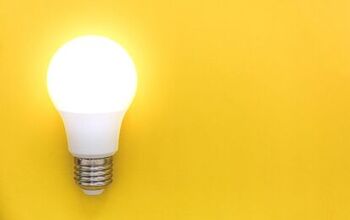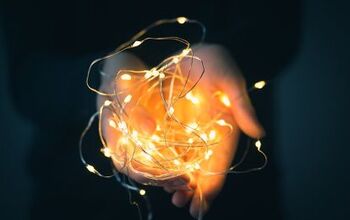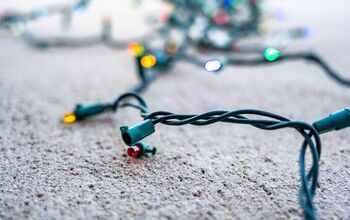Can You Mix LED and Incandescent Lights? (Find Out Now!)

Nearly everyone knows that LED lights are much better for the environment than their incandescent counterparts. Not to mention, they have a longer lifespan and will save you money on your energy bills. However, when making the switch from incandescent to LED, there are many questions that arise. For example: Can you mix LED and incandescent lights together?
Believe it or not, this is a common mistake that many people make when it comes to LED lighting. When you’re transitioning to LED lights, it may be tempting to swap out one or two bulbs at a time and leave a few incandescent bulbs in. However, this is not recommended. Mixing LED and incandescent lights results in poor performance and when you use them both on the same circuit, the incandescent lights draw more power which will cause the LED lights to flicker.
Instead, if you’re changing one incandescent light bulb to LED, you should change them all. We’ll explore more about why mixing LED and incandescent lights is a big no-no, as well as provide you with some other do’s and don’ts when it comes to LED lights.
Can LEDs Be Combined with Incandescent Bulbs in the Same Fixture?
Unfortunately, mixing LEDs with incandescent bulbs in the same multi-socket enclosed fixture can cause harm to your LEDs. The incandescent bulbs will raise the ambient temperature of the entire fixture. Even if your LEDs are high-quality and have a well-designed heat sink, they can still fail because of the excessive heat that they weren’t designed to withstand.
Another common mistake people make is to purchase LEDs for a fixture that previously had incandescent bulbs and gradually replace them one by one. Though, it’s much better to change out all the bulbs at once, or you risk significantly reducing the life of your LEDs. Over time, the heat of incandescent bulbs will destroy the sensitive semiconductors, electronic chips, and drivers in LED bulbs.
LED bulbs perform best in a cool environment and since incandescent bulbs are naturally much hotter, they do not pair well. Additionally, when on the same circuit, incandescent bulbs draw more power than LEDs. As such, the LED bulbs will receive less power, resulting in the possibility of the bulbs buzzing, flickering, or failing entirely.
Mixing LED and Incandescent Bulbs in a Dimmable Fixture
If you have a dimmable fixture, it’s also not recommended to combine incandescent bulbs with LED bulbs. Oftentimes, you’ll find that the LEDs flicker, dim poorly, or simply don’t work at all. The dimmer, which has been functioning properly and is compatible with your traditional incandescent bulbs, may not operate as well with the newer LEDs since it’s an older system.
The issue here isn’t the LEDs themselves, it’s simply that you should not combine LEDs with incandescent bulbs in a dimmable fixture (or any fixture for that matter).
Can You Connect Incandescent and LED Mini String Lights Together?
Just like you shouldn’t combine LED and incandescent bulbs together in the same fixture, you also shouldn’t connect incandescent and LED mini string lights together. The logic behind this has to do with the amount of electrical current. Incandescent string lights necessitate a larger power output than their LED counterparts.
Hooking up incandescent and LED light strings one after the other will cause the power that’s drawn by the incandescent lights to overload, frying the LED strings. Therefore, it’s best to keep LEDs and incandescent lights separate, and run them each out of their own outlet.
Can You Use LED Bulbs in an Incandescent or Halogen Fixture?
Assuming that the bulbs fit and are the proper voltage, yes, you can replace all your incandescent or halogen bulbs with an LED solution. However, the first thing to consider is the fitting of the bulb base. There are many different bulb bases, but the E27 screw type and the GU10 pin type are the most common. Both of these bases also come in LED models.
In some cases, the incandescent or halogen bulb is designed to be decorative and visible on the outside of your fixture. When this happens, it’s important that the LED replacement is also visually appealing. Fortunately, there are plenty of aesthetic LED lighting options to choose from – including Edison bulbs or globe bulbs.
Lumens to Watts Conversion
When you’re searching for LED replacement bulbs for your traditional fixtures, you must also consider the wattage. The wattage of the LED bulbs does not have to be the same wattage as the older incandescent bulbs. In this case, look out for Lumens, which refers to the light output, while wattage is the power consumption.
For instance, your LED bulb may use 8.5 watts, and a halogen might use approximately 30 watts of energy to be as bright as a 60-watt incandescent bulb. Likewise, an 18 Watt halogen bulb yields about 220 lumens, while an 18 Watt LED bulb yields closer to 1300 lumens. With this in mind, here’s a Lumens to Watt conversion chart that should aid you in finding the proper LED replacement for your halogen or incandescent bulbs.
| Brightness in Lumens | 220+ | 400+ | 700+ | 900+ | 1300+ |
| Incandescent | 25W | 40W | 60W | 75W | 100W |
| Halogen | 18W | 28W | 42W | 53W | 70W |
| CFL | 6W | 9W | 12W | 15W | 20W |
| LED | 4W | 6W | 10W | 13W | 18W |
Do LED Bulbs Require Special Fixtures?
Another common mistake that folks will assume is that all fixtures are suitable for LED bulbs. Or, assuming that all LED fixtures accept any type of LED bulb. The idea of “one size fits all” doesn’t always apply to LEDs. Using the wrong light fixture can actually reduce the lifespan of your LED bulbs and possibly result in malfunction or an excessive amount of heat. Additionally, mismatching the bulb with the fixture may cause the fixture to not emit the proper amount of light.
Again, LED bulbs perform best in cool conditions and any fixture that allows for this is suitable for LEDs. A good place to start is to understand which fixtures are NOT recommended for use with LEDs. As previously mentioned, it’s common for some fixtures with dimming features to not be compatible with LEDs. Aside from that, here are some enclosed fixtures that are not suitable for LEDs and will actually end up killing them quicker:
- Outdoor porch lights that are covered in glass to shield from weather.
- Bathroom and kitchen semi-flush enclosed lights that suspend near the ceiling.
- Recessed, pot, or can lights that rest inside the ceiling and are shielded by a glass front and trim.
- Decorative, retro mason jar housing lights that you might find in restaurants and are airtight.
- Some track head lights and table lamps.
The key here is that enclosed fixtures do not have enough space to dissipate the heat, which doesn’t allow for the proper conditions for LED bulbs to thrive. Any fixture that is well-ventilated, has the necessary heat dissipation, and is open on all sides is ideal for LED bulbs. Alternatively, you can opt for an enclosed rated LED bulb, with a large aluminum heat sink that disperses heat quickly and effectively.
Related Questions
How long do LED lights last?
Although LED lighting does last longer than incandescent bulbs, replacements will be required eventually. The average lifespan of an LED lamp is approximately 50,000 hours, which translates to between five and six years on average. To put things in perspective, this is roughly 50 times more than incandescent bulbs and eight to 10 times more than their compact fluorescent (CFL) counterparts.
How do I know if my Christmas lights are LED or incandescent?
A great way to determine if your string lights are LED or incandescent is to feel the temperature of the bulbs. Simply place your finger right on top of one of the bulbs. If it’s hot to the touch, it’s likely an incandescent bulb. Whereas, if it’s barely warm or slightly cool to the touch, you have LED bulbs.

Jessica considers herself a home improvement and design enthusiast. She grew up surrounded by constant home improvement projects and owes most of what she knows to helping her dad renovate her childhood home. Being a Los Angeles resident, Jessica spends a lot of her time looking for her next DIY project and sharing her love for home design.
More by Jessica Stone



























